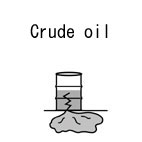| Case Name |
Leakage of crude oil caused due to abrasion of pipe from external corrosion of crude oil piping |
| Pictograph |

|
| Date |
February 15, 1996 |
| Place |
Kawasaki, Kanagawa, Japan |
| Location |
Oil terminal for imported crude oil |
| Overview |
Crude oil spilled from piping at a crude oil storage terminal in Kanagawa prefecture in 1996. An opening caused by corrosion at small-diameter piping was considered to be due to a salt breeze and seawater splashes on the piping. There could have been puddles of seawater on the piping. External corrosion was overlooked because the piping was re-painted without completely removing old paint. Underneath the old paint, corrosion proceeded and made an opening without drawing the attention of inspectors. The crude oil leaked from this opening. |
| Incident |
Crude oil leaked from piping near a storage tank of a crude oil terminal, and spilled into the sea. |
| Processing |
Storage |
| Substance |
Crude oil |
| Type of Accident |
Leakage, environmental pollution |
| Sequence |
On February 15th, 1996, oil was found on the sea surface near a jetty during a routine patrol. Crude oil was leaking from small piping of an air vent at a remote control valve near the crude oil tank, and oil spilled onto the sea. The valve was closed immediately by remote control from the control room, and leakage was reported to related divisions of the terminal. Sandbags were piled up along the embankment. The piping was constructed 13 years and 8 months before the accident (May, 1982). |
| Cause |
The leakage was caused by external corrosion due to long-term use of small piping installed near the sea. The reasons for the pipe opening are as follows:
1) The part was splashed with sea water which remained at the part and caused corrosion. Corrosive action of seawater opened the piping.
2) Piping was painted after incomplete removal of old paint and progress of corrosion could not be found.
Generally, a small-diameter pipe readily opens because the wall is thin. |
| Response |
1. Valves were closed.
2. Sandbags were piled up around the leak point.
3. An oil fence was extended.
4. Crude oil was treated/recovered with a dispersant and an oil mat. |
| Countermeasures |
1. Strengthening anti-corrosion management such as checks for corroded part and application of anti-corrosive paint.
2. Inspection of screw joint parts. |
| Knowledge Comment |
The piping, particularly small piping with branches along a coastline is one of the parts that are most commonly subject to external corrosion. Therefore, particular attention is required. As many oil refineries, oil terminals, and petrochemical complexes are located along coastlines in Japan, this can be a serious problem. |
| Background |
External corrosion near a coastline was already well recognized at the time of the accident. Inspection and necessary repair should have been done. It is not certain whether this accident was unfortunate because an inspection turn of the point was late or this accident occurred due to neglect of the corrosion. |
| Reason for Adding to DB |
Example of external corrosion of piping near a coastline |
| Scenario |
| Primary Scenario
|
Poor Value Perception, Poor Safety Awareness, Inadequate Risk Recognition, Carelessness, Insufficient Precaution, Inadequate Check, Production, Hardware Production, Piping Construction, Usage, Maintenance/Repair, Insufficient Painting, Failure, Abrasion, Erosion by Sea Water, Secondary Damage, External Damage, Leakage
|
|
| Sources |
Kawasaki City Fire fighting station Prevention division Peace section. Crude oil leakage accident at H oil terminal Co. K office. Material of the Kawasaki City Complex safety countermeasures committee. (1996)
|
| Consequences |
45 L of crude oil spilled into the sea and spread over 15 m x 200 m from a wharf. |
| Field |
Chemicals and Plants
|
| Author |
YOSHINAGA, Jun (Graduate School of New Frontier Sciences, The University of Tokyo)
TAMURA, Masamitsu (Center for Risk Management and Safety Sciences, Yokohama National University)
|